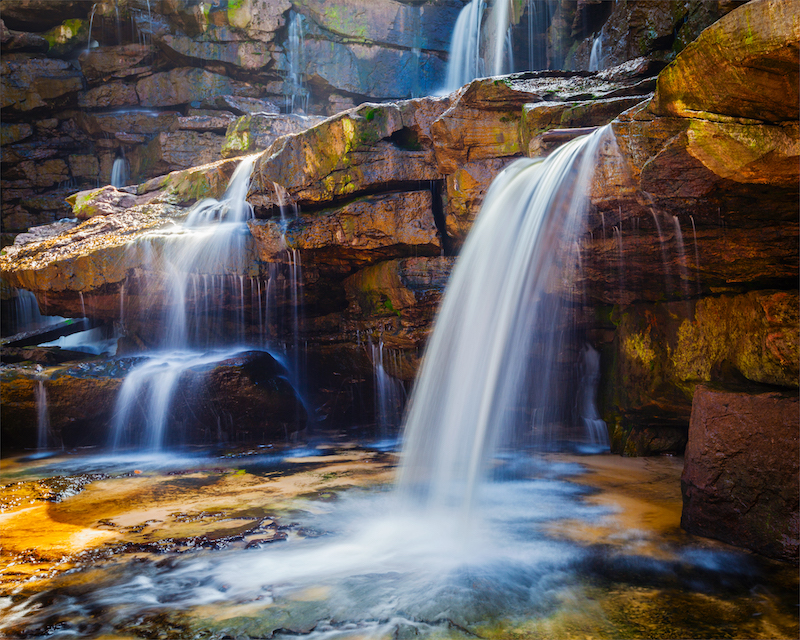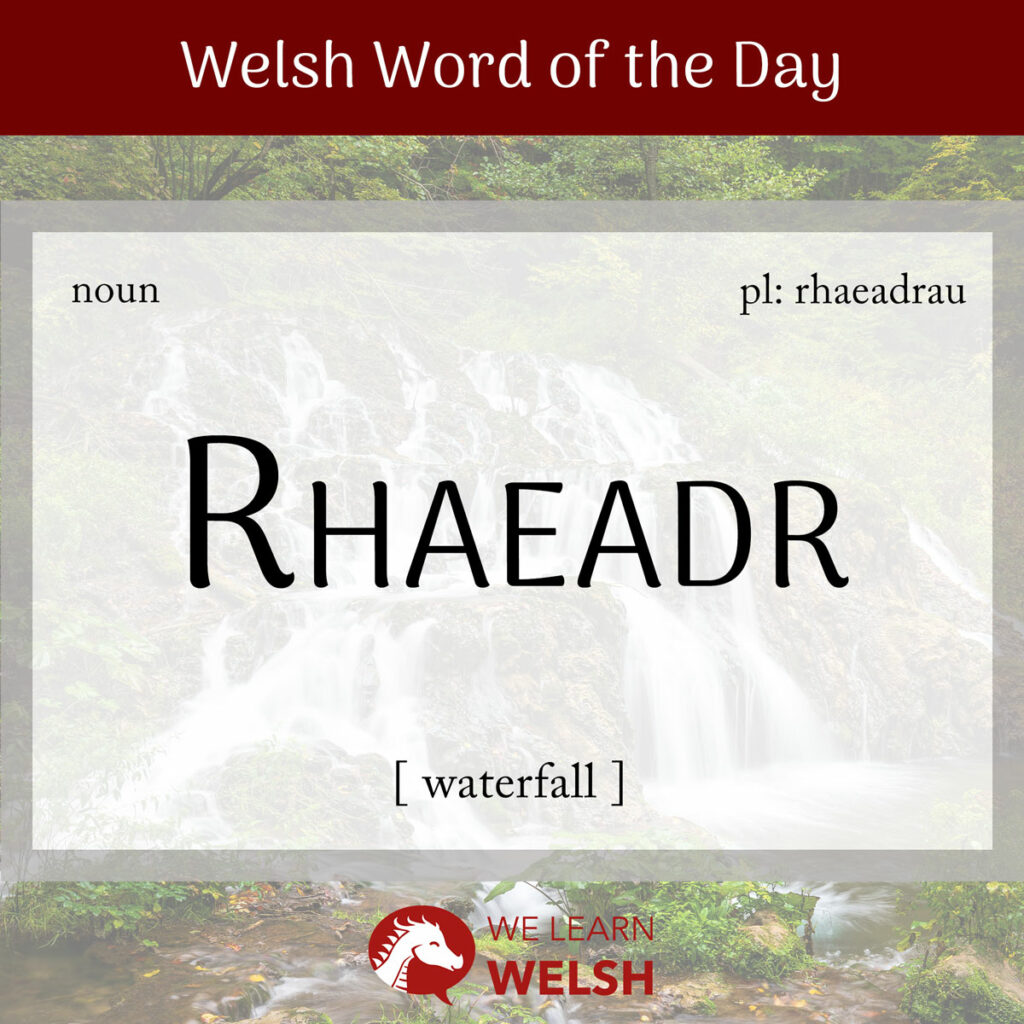One of my favourite walks as a child was to Water-Break-Its-Neck in Warren Wood, near New Radnor. I loved to watch the fierce white dŵr (water) cascade over the cerrig (rocks), amidst thick green mwsogl (moss).
Water-Breaks-Its-Neck, of course, is an example of a rhaeadr (waterfall). It’s far from the only one worth visiting in Wales – Cymru is a mynyddig (mountainous) country, and rhaeadrau (waterfalls) feature prominently in both its physical and its cultural tirwedd (landscape). From the gorgeous 70-meter Pistyll Rhaeadr near the border with England, to Rhaeadr Tresaith, which runs directly into the sea, you can follow this word to find breath-taking beauty spots in every part of the country.
rhaeadr
waterfall
Like all words, this noun has changed over time. Older Welsh texts show various spellings, including raeadyr, rheadr, and reatir. Its plural forms are just as diverse, with rhaeadrau, rheidr, and rhëydr all attested. The word originates from the Proto-Celtic reyatrom, which likely stems from the Proto-Indo-European root hreyh- (to flow). It also has a linguistic cousin in the Irish riathar.
Rhaeadr is a feminine noun. However, this doesn’t mean it undergoes mutation after y (the), as most feminine nouns do. This is because it starts with rh, which, despite being subject to soft mutation, doesn’t always undergo it in cases where we would typically expect it.
Soft mutation
raeadr
Nasal mutation
N/A
Aspirate mutation
N/A
It’s a bit confusing, but luckily, you can rest assured that the other mutation necessitated by feminine nouns will function as normal here – any adjective used to describe rhaeadr should soft mutate. So, y rhaeadr ddisglair (the sparkling waterfall).
This word, as in English, can be used to describe any physical point at which an afon (river / stream) descends over a cwymp (descent) of some kind, leading to the stunning rhyfeddod (wonderful phenomenon) of the water literally disgyn (falling) through the awyr (air).
Ymwelais â‘r rhaeadr ger Betws-y-Coed.
I visited the waterfall near Betws-y-Coed.
It’s no surprise that they often become famous landmarks and attractions around the world. Victoria Falls between Sambia (Zambia) and Simbabwe (Zimbabwe) is enwog (famous) for its incredible width. The niwl (mist) that rises from the water is called The Smoke That Thunders in the local language, Lozi, which would be y mwg sy’n taranu in Welsh.
Another of the most well-known is Niagara Falls, which actually consists of tair rhaeadr wahanol (three separate waterfalls). These are famous for their harddwch (beauty) and nerth (power) and are also an incredibly useful source of trydan dŵr (hydro-electric energy).

But the world’s tallest rhaeadr is in De America (South America), in a remote jyngl (jungle) of Feneswela (Venezuela). Angel Falls are nearly 1km high, including dyfroedd gwylltion (rapids) at the base of the fall. More than half of this height consists of just one single cwymp (drop). That certainly puts my beloved Water-Break-Its-Neck to shame!
Although rhaeadr is the only word I have ever used for waterfall and will be understood throughout Wales, in some parts of the South, people may colloquially use sgwd instead. The words pistyll (spouting water), disgynfa (falling-place), pwll (pool), and ffrwd (fast-flowing water) also appear in the place names of rhaeadrau throughout the country.
Here are some good adjectives you could use to describe a rhaeadr:
- gwyllt = wild / rushing
- ffyrnig = fierce
- serth = steep
- tawel = quiet / peaceful
- heddychlon = peaceful
- hardd = beautiful
- trawiadol = striking
Fydd well gen ti weld rhaeadr neu drobwll?
Would you rather see a waterfall or a whirlpool?
As with other geological features, rhaeadr forms the basis of many place names in Wales, like that of Rhaeadr Gwy, a town very near where I grew up. It’s often part-anglicised to Rhayader, pronounced in English a bit like the word raider.
Sadly, the waterfall after which Rhaeadr Gwy got its name was destroyed in the late 1700s as the town expanded, with the building of a pont (bridge) to link it to the adjacent village of Cwmdauddwr – this name is a shortening of a longer, older Welsh name meaning meeting of two waters, referring to the joining of the Afon Gwy (River Wye) and the Afon Elan (River Elan).
The loss of the rhaeadr of Rhaeadr Gwy is a tragedy. But the beauty of dŵr remains ever-present in this charming little market town, as the Afon Gwy continues to trundle past the town, connecting it to the Afon Elan and the stunning cronfeydd (reservoirs) of Cwm Elan (Elan Valley).

